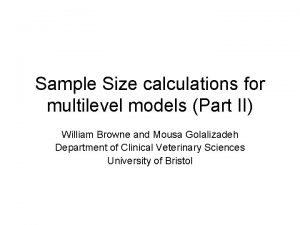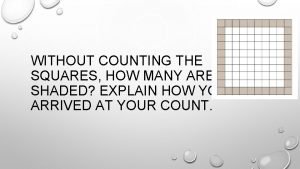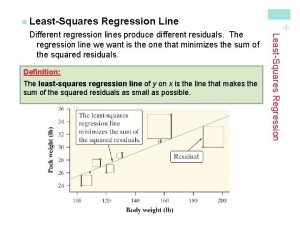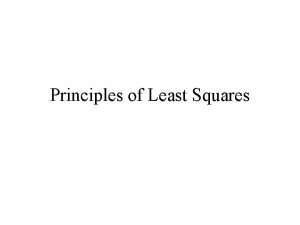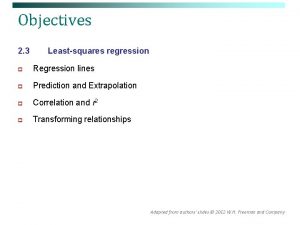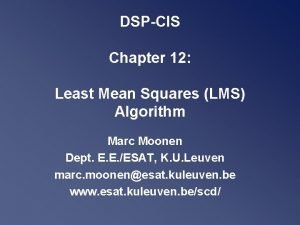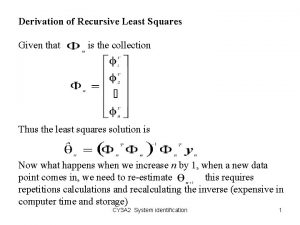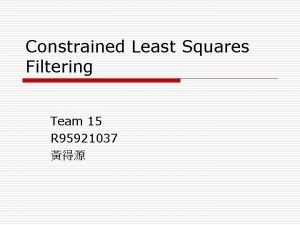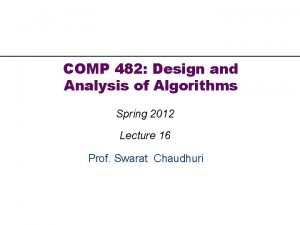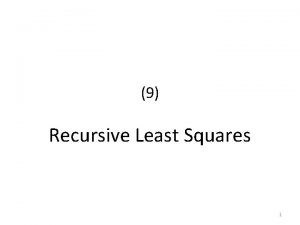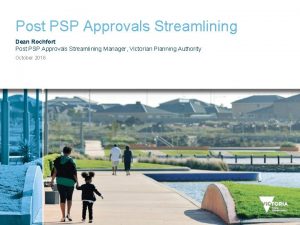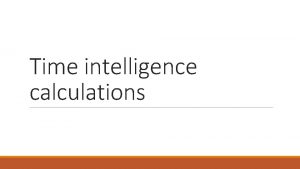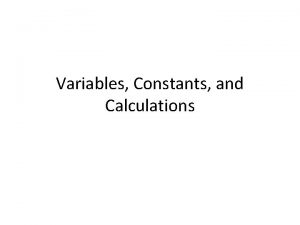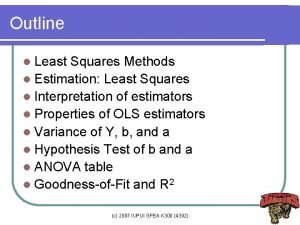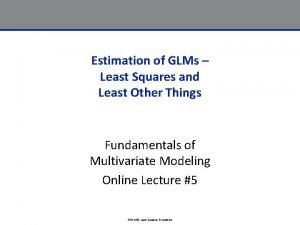PSP Calculations least squares size least squares time











- Slides: 11

PSP Calculations least squares size, least squares time confidence interval (range), Methods A, B, C, and D CS 1813 Discrete Mathematics, Univ Oklahoma Copyright © 2000 by Rex Page 1

q Data Mean, Variance, and Correlation § x = [x 1, x 2, … xn] § y = [y 1, y 2, … yn] q Definitions § § § Note: These computations are exact in ACL 2 Significant digits no problem x = x 1 + x 2 + … + xn x - = [x 1 - , x 2 - , … xn - ] x 2 = [x 12, x 22, … xn 2] x y = [x 1 y 1, x 2 y 2, … xn yn] x = ( x)/n mean — average of [x 1, x 2, … xn] x 2 = (x - )2 variance — average of squared deviations x from mean § s(x, y) = (x - ) (y - ) scatter — average of products x y of deviations § r(x, y)2 = s(x, y)2/( x 2 y 2) correlation squared — squared scatter, scaled by variances CS 1813 Discrete Mathematics, Univ Oklahoma Copyright © 2000 by Rex Page 2

0 + x Least Squares Line 2 § x = [x 1, x 2, … xn] § y = [y 1, y 2, … yn] q Definitions 1 1 2 k 1 § x + = [x 1 + , x 2 + , … xn + ] § x = [ x 1, x 2, … xn] k y-axis q Data • = • y • • • (x , y ) • x-axis • • • q Goal: choose 1 and 0 to minimize ( 1 x + 0 - y)2 § Linear, least squares model of the data q Solution § 1 = s(x, y)/ x 2 slope —scatter, scaled by variance of abscissa § 0 = y - 1 x y-intercept —mean of y, less -scaled mean of x Note: Computations exact in ACL 2 Significant digits no problem CS 1813 Discrete Mathematics, Univ Oklahoma Copyright © 2000 by Rex Page 3

Least-Squares Size Estimate correcting for bias in historical estimates q Bias measures consistent over-estimation (or consistent under-estimation) § Historical size estimates: e 1, e 2, … en § Historical actual sizes: s 1, s 2, … sn § Least-squares fit Note: n 3 ü Data points: {(e 1 , s 1), (e 2 , s 2), …. (en , sn)} ü Least squares fit delivers: 0, 1, – Equation of line minimizing sum of squared deviations ü e = size-estimate produced from conceptual design ü s = 0 + 1 e – reduced-bias estimate, new project CS 1813 Discrete Mathematics, Univ Oklahoma Copyright © 2000 by Rex Page 4

Least-Squares Time Estimate convert Lo. C estimate to Time, correct for bias q Use actual time versus size estimated size (instead of actual size versus estimated size) § Historical size estimates: e 1, e 2, … en Note: n 3 § Historical actual development time: t 1, t 2, … tn § Least-squares fit ü Data points: {(e 1 , t 1), (e 2 , t 2), …. (en , tn)} ü Least squares fit delivers: 0, 1, – Equation of line minimizing sum of squared deviations ü ui = 0 + 1 e i – reduced bias time-estimate, historical ü e = size-estimate produced from conceptual design ü t = 0 + 1 e – time estimate, new project q Conversion of size to time § 1 –least-squares scale adjustment (time-per-loc) § 0 – least-squares bias adjustment (time) CS 1813 Discrete Mathematics, Univ Oklahoma Copyright © 2000 by Rex Page 5

Prediction Interval for estimates generated by regression formula q x = sum of estimated object sizes for current project § Called xk in DSE Appendix A 8 q y = 0 + 1 x Note: All data is historical except x § Estimated total time q Prediction interval (range): [y – D, y + D] § Confidence level is estimated probability that actual development time will fall in this range(eg, conf level = 70%) § Computed using Student’s t-statistic ü c = confidence level (eg, c = 70% or c = 90%) ü = average raw estimate = (1/n) ei App A 8 uses sample variance ü 2 = (1/n) ( 0 + 1 ei - ti)2 Here, ordinary variance 2 2 (simplifies code, close enough) ü d = (1/n) (ei - ) ü D = BS-t(1 – (1 - c)/2, n – 2) sqrt( 2(1 + (x - )2/d 2)/n) q Examples § BS-t(0. 85, 8) = 1. 108 range multiplier, c=70% confidence, 8 deg freedom § BS-t(0. 95, 8) = 1. 860 range multiplier, c=90% confidence, 8 deg freedom inverted Student's t CS 1813 Discrete Mathematics, Univ Oklahoma (called t(a/2, n-2) in DSE App 8) Copyright © 2000 by Rex Page 6

Method A: Estimating Development Time when sufficiently correlated historical data is available q Sufficiently correlated historical data means § Three or more (estimated Lo. C, actual hours) pairs § Estimated Loc vs Actual Hours correlated (r 2 > 0. 5) q Method A § Estimate Lo. C following usual procedure (call this s) § Calculate 1 and 0 using historical database ü Least squares fit: y = 0 + 1 x, y = hours, x = Lo. C ü Data (yi, xi) = ith (estimated Lo. C, actual hours) pair § Compute estimated time: h = 0 + 1 s § Compute D = prediction interval half-width § Time estimate = h D ü State 70% or 90% confidence, depending on what t-value used for D CS 1813 Discrete Mathematics, Univ Oklahoma Copyright © 2000 by Rex Page 7

Method B: Estimating Development Time when past estimates are not sufficiently correlated q Correlated data, measured Lo. C (not estimated Lo. C) § Historical data with 3 or more (actual Lo. C, actual hours) pairs § Actual Lo. C data is sufficiently correlated: r 2 > 0. 5 q Method B § Calculate 0 , 1 : least squares fit to (actual Lo. C, actual hrs) data ü Regression line is in (actual Lo. C, actual hrs) space – Method A was in (estimated Lo. C, actual hrs) space § Estimate Lo. C: let s stand for the estimate § Compute estimated time: h = 0 + 1 s § Compute D = prediction interval half-width ü Compute as in Method A, but in different regression space § Time estimate = h D CS 1813 Discrete Mathematics, Univ Oklahoma Copyright © 2000 by Rex Page 8

Method C: Estimating Development Time when historical data is not sufficiently correlated q Little historical data available and/or poor correlation § Historical data with one or more (actual Lo. C, actual Time) pairs § Data not well correlated: r 2 < 0. 5 q Method C § Calculate productivity = total Lo. C / total Time § Calculate estimated hours = estimated Lo. C / productivity § Calculate prediction interval (if 2 or more projects in history) ü Shortest likely development time = estimated Lo. C / max productivity ü Longest likely development time = estimated Lo. C / min productivity – Min and max productivities computed from individual projects in historical database ü No prediction interval if historical data contains only one project CS 1813 Discrete Mathematics, Univ Oklahoma Copyright © 2000 by Rex Page 9

Choosing an Estimation Method q Use Method A if § Historical data has 3 or more projects, and § Historical Lo. C estimates are sufficiently correlated with actual time measurements (r 2 > ½) q Use Method B if § Historical data has 3 or more projects, and § Historical actual Lo. C measurements are sufficiently correlated with actual time measurements (r 2 > ½) ü But insufficient estimated-Lo. C-vs-actual-Time correlation q Use Method C if § Historical data has 1 or more projects, and § Neither Method A nor Method B can be used q Use Method D (no calculated estimate) if § There is no historical data CS 1813 Discrete Mathematics, Univ Oklahoma Copyright © 2000 by Rex Page 10

The End CS 1813 Discrete Mathematics, Univ Oklahoma Copyright © 2000 by Rex Page 11
 Types of connections in steel structures
Types of connections in steel structures Sample size calculations in multilevel modelling
Sample size calculations in multilevel modelling Youcubed squares and more squares answers
Youcubed squares and more squares answers My age
My age Least squares regression line definition
Least squares regression line definition Least squares solution
Least squares solution Least squares regression line statcrunch
Least squares regression line statcrunch Lms cis
Lms cis Recursive least squares python
Recursive least squares python Constrained least square filter
Constrained least square filter 4d3d41669541f1bf19acde21e19e43d23ebbd23b
4d3d41669541f1bf19acde21e19e43d23ebbd23b Recursive least squares example
Recursive least squares example

